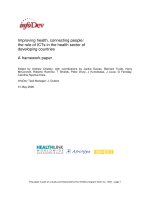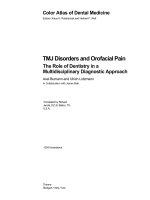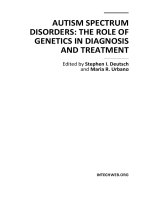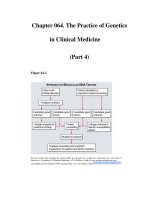THE ROLE OF SURGERY IN HEART FAILURE - part 4 ppsx
Bạn đang xem bản rút gọn của tài liệu. Xem và tải ngay bản đầy đủ của tài liệu tại đây (105.01 KB, 2 trang )
those who have known coronary disease and
severe left ventricular dysfunction (LVEF less
than 0.35) with breathlessness but only mild
angina. Viability testing is redundant in patients
who have unstable angina, postinfarction angina,
or chronic stable angina, because revasculariza-
tion is indicated for relief of symptoms. For ische-
mic patients who have heart failure symptoms but
minimal angina, the combination of good target
vessels with more than 25% myocardial viability
suggests potential to benefit from CABG [46].
For those who have less than 25% viability or
poor target vessels, or are reoperative candidates,
surgery is unlikely to provide benefit.
Observational studies have documented sub-
stantial improvements in LV regional and global
function following revascularization of hibernat-
ing myocardium [47,48]. This procedure provides
relief from heart failure symptoms, improved sur-
vival, and important quality-of-life benefit. A
comprehensive meta-analysis of largely retrospec-
tive data has been performed by Allman and col-
leagues [49]. In 24 studies reporting patient
survival after viability testing, annual death rates
were analyzed to produce a risk-adjusted relation-
ship between the severity of LV dysfunction, pres-
ence of viability, and survival benefit associated
with revascularization. The study included 3088
patients who had LVEF 32% Æ 8% followed
for 25 Æ 10 months. For patients who had
stunned or hibernating myocardium revasculari-
zation was associated with a 79.6% reduction in
the annual mortality rate (16% versus 3.2%,
P ! .0001) compared with medical treatment.
In contrast, patients who did not have viability
had intermediate mortality, tending to higher
rates with CABG versus medical therapy (7.7%
versus 6.2%). Patients who had viability showed
a direct relationship between the severity of LV
dysfunction and magnitude of benefit with revas-
cularization. No benefit was associated with
revascularization in patients who did not have vi-
ability at any level of LVEF. The perioperative
mortality rates were impressively high in patients
who did not have viability (around 10%) but
negligible in those who had viability. This differ-
ence in mortality is curious given the time frame
of improvement in wall motion following
revascularization.
Histopathologic studies have indicated a grad-
ual increase in ultrastructural damage and degree
of myocardial fibrosis as the ischemic process
progresses through stunning, hibernation, non-
transmural scar, and full-thickness scar [47].
Obviously scar never improves in function after
revascularization even if covered with a veneer
of healthy epicardial muscle following thromboly-
sis. Bax and colleagues [50] prospectively studied
patients who had ischemic cardiomyopathy and
left ventricular dysfunction using preoperative as-
sessment of regional perfusion, glucose use, and
contractile function. Of the dysfunctional seg-
ments, 22% were stunned, 23% were hibernating,
and 55% were scar tissue. In stunned myocardium
contractile function improved significantly at
3 months but without further improvement at
14 months. Some 30% of stunned segments did
not improve. In hibernating segments 31% had
improved by 3 months and 61% had recovered
fully by 14 months. In a similar study using intra-
operative myocardial biopsy from dysfunctional
myocardium, Haas showed only 31% of stunned
segments and 18% of hibernating segments to ob-
tain complete functional recovery after 1 year [47].
Failure to improve was associated with more se-
vere degenerative changes in the myocyte, includ-
ing depletion of sarcomeres, accumulation of
glycogen, loss of sarcoplasmic reticulum, and cel-
lular sequestration. Using gadolinium-enhanced
contrast MRI, Kim and colleagues [21] showed
that 78% of dysfunctional segments identified as
completely viable showed improvement in con-
tractility after revascularization. In contrast,
90% of segments with 50% to 75% of wall thick-
ness scar did not improve after revascularization.
The realization that the globular ischemic
cardiomyopathy ventricle can be surgically re-
stored to an elliptic shape by exclusion of scar is
largely attributable to Dor [51]. Dor’s endoven-
tricular circular patch plasty followed pioneering
attempts at physiologic reconstruction by Jatene
and Cooley [52]. Dor’s major contribution was
to remove endocardial scar, exclude akinetic sep-
tum, restore the curvature of the anterolateral
wall, and undertake complete myocardial revascu-
larization and correction of mitral regurgitation.
In the event of spontaneous or inducible ventricu-
lar tachycardia, cryotherapy was also applied to
the edges of the resection (50% of cases). Between
development of the surgical principles in 1984 and
2002, the Dor group operated on 1050 patients
who were predominantly NYHA III or IV with
LVEF less than 35%, LVESVI greater than 50
mL/m
2
, LVEDVI greater than 100 mL/m
2
, and
mean pulmonary arterial pressure greater than
25 mm Hg [53]. One third of the cases had mitral
regurgitation requiring repair. A balloon inflated
to the theoretic diastolic capacity of the patient
149SURGERY FOR HEART FAILURE
Maximizing Survival Potential in Very
High Risk Cardiac Surgery
Stephen Westaby, MS, PhD, FRCS
*
,
L. Balacumaraswami, MBBS, FRCS (C-Th), R. Sayeed, PhD, FRCS
Oxford Heart Centre, John Radcliffe Hospital, Oxford, UK
The mean age and risk profile of patients
referred for cardiac surgery is constantly increas-
ing. Surgeons are now inclined to accept high-risk
patients because interventional cardiology pro-
vides less invasive alternatives for an overlapping
patient cohort. As risk profile increases so does
hospital mortality. A survey of 8641 patients who
underwent coronary artery bypass operations in
New England showed an overall mortality of
4.48%, of which 65% could be directly attributed
to postcardiotomy myocardial failure [1].In
the PURSUIT trial, which randomized patients
who had coronary bypass and unstable angina
to a glycoprotein IIb/IIIa inhibitor or placebo,
the 7-day mortality or myocardial infarction rate
was 22.3% in almost 700 patients in the control
arm [2]. A collective review of 279 patients who
had dialysis-dependent coronary bypass reported
a 12.2% hospital mortality [3]. Similarly the
Mayo Clinic Group reported a 14% perioperative
mortality for patients who had aortic valve
replacement with a left ventricular ejection
fraction (LVEF) less than 35% and a borderline
transvalvular gradient [4]. Intraoperative
myocardial injury remains prevalent in the in-
creasingly elderly surgical population because
tolerance to ischemia is reduced in aged myocar-
dium [5].
Patients who are difficult to wean from car-
diopulmonary bypass (CPB) and those who sub-
sequently deteriorate into a low cardiac output
state have mortality rates between 50% and 80%
[6]. In established cardiogenic shock, conventional
treatment with inotropes, the intra-aortic balloon
pump (IABP), or temporary circulatory support
devices has not substantially improved survival.
In an analysis of risk factors and outcomes for
postcardiotomy mechanical support in 19,985
Cleveland Clinic patients, 0.5% received circula-
tory support with overall survival of 35% [7]. In-
cluded were patients who were converted to the
HeartMate I implantable system and bridged to
transplantation with 72% survival. In the absence
of the transplant option, more innovative circula-
tory support strategies are required to improve
survival in the postcardiotomy setting.
Mechanisms of postcardiotomy myocardial
dysfunction
Efforts to improve surgical results in patients
who have heart failure depend on myocardial
protection and preservation of contractile func-
tion in the postoperative period. The clinical
scenario is well known. The patient who has
myocardial ischemia or chronically impaired left
ventricular function undergoes combined valve
and coronary bypass surgery. The ischemic time
exceeds 90 minutes and despite myocardial pro-
tection with blood cardioplegia, inotropic support
is required to separate from CPB. The vaso-
constricted patient returns to the intensive care
unit with borderline cardiac index and a blood
pressure of 110/70 mm Hg. Over the next 4 hours
the blood pressure remains acceptable on inotro-
pic support but the urine output dwindles and the
ankles are cold. An IABP is deployed, seems to
function well, and optimism returns until the
blood gases reveal lactic acidosis and a pH of
* Corresponding author. Oxford Heart Centre, John
Radcliffe Hospital, Headley Way, Headington, Oxford
OX3 9DU, UK.
E-mail address: (S. Westaby).
1551-7136/07/$ - see front matter Ó 2007 Published by Elsevier Inc.
doi:10.1016/j.hfc.2007.05.001 heartfailure.theclinics.com
Heart Failure Clin 3 (2007) 159–180









